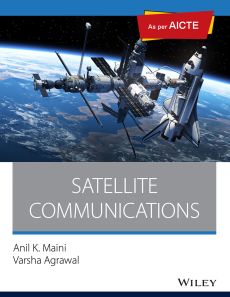Satellite Communications, As per AICTE
ISBN: 9788126520732
504 pages
Publication Year: 2019
For more information write to us at: acadmktg@wiley.com

Description
The text is an up-to-date and comprehensive title in the field of satellite communication technology and applications. It offers full coverage of the theoretical and practical concepts of the communication satellites and also briefly talks about the other applications including remote sensing, weather forecasting, navigation, scientific and military. The essentials of satellite technology are explained by giving an introduction to the fundamental topics such as orbits and trajectories, launch and in-orbit operations before going on to describe satellite hardware.
Preface
1. Introduction to Satellites and Their Applications
1.1 What is a Satellite?
1.2 History of Evolution of Satellites
1.3 Evolution of Launch Vehicles
1.4 Future Trends
2 Satellite Orbits and Trajectories
2.1 Definition of an Orbit and a Trajectory
2.2 Orbiting Satellites: Basic Principles
2.3 Orbital Parameters
2.4 Injection Velocity and Resulting Satellite Trajectories
2.5 Types of Satellite Orbits
3 Satellite Launch and In-Orbit Operations
3.1 Acquiring the Desired Orbit
3.2 Satellite Launch Sequence
3.3 Orbital Perturbations
3.4 Satellite Stabilization
3.5 Orbital Effects on Satellite’s Performance
3.6 Eclipses
3.7 Look Angles of a Satellite
3.8 Earth Coverage and Ground Tracks
4 Satellite Hardware
4.1 Satellite Subsystems
4.2 Mechanical Structure
4.3 Propulsion Subsystem
4.4 Thermal Control Subsystem
4.5 Power Supply Subsystem
4.6 Attitude and Orbit Control
4.7 Tracking, Telemetry and Command Subsystem
4.8 Payload
4.9 Antenna Subsystem
4.10 Space Qualification and Equipment Reliability
5 Communication Techniques
5.1 Types of Information Signals
5.2 Amplitude Modulation
5.3 Frequency Modulation
5.4 Pulse Communication Systems
5.5 Sampling Theorem
5.6 Shannon–Hartley Theorem
5.7 Digital Modulation Techniques
5.8 Multiplexing Techniques
6 Multiple Access Techniques
6.1 Introduction to Multiple Access Techniques
6.2 Frequency Division Multiple Access (FDMA)
6.3 SCPC Systems
6.4 MCPC Systems
6.5 Time Division Multiple Access (TDMA)
6.6 TDMA Frame Structure
6.7 TDMA Burst Structure
6.8 Computing Unique Word Detection Probability
6.9 TDMA Frame Efficiency
6.10 Control and Coordination of Traffic
6.11 Frame Acquisition and Synchronization
6.12 FDMA vs. TDMA
6.13 Code Division Multiple Access (CDMA)
6.14 Space Domain Multiple Access (SDMA)
7 Satellite Link Design Fundamentals
7.1 Transmission Equation
7.2 Satellite Link Parameters
7.3 Frequency Considerations
7.4 Propagation Considerations
7.5 Noise Considerations
7.6 Interference-Related Problems
7.7 Antenna Gain-To-Noise Temperature (G/T) Ratio
7.8 Link Design
8 Earth Station
8.1 Earth Station
8.2 Types of Earth Station
8.3 Earth Station Architecture
8.4 Earth Station Design Considerations
8.5 Earth Station Testing
8.6 Earth Station Hardware
8.7 Satellite Tracking
8.8 Some Representative Earth Stations
9 Communication Satellites
9.1 Introduction to Communication Satellites
9.2 Communication-Related Applications of Satellites
9.3 Frequency Bands
9.4 Payloads
9.5 Satellite vs. Terrestrial Networks
9.6 Satellite Telephony
9.7 Satellite Television
9.8 Satellite Radio
9.9 Satellite Data Communication Services
9.10 Important Missions
10 Other Applications
10.1 Remote Sensing Satellites
10.2 Weather Forecasting Satellites
10.3 Navigation Satellites
10.4 Scientific Satellites
10.5 Military Satellites
Key Terms
Multiple-Choice Questions
Review Questions
Answers
Index

